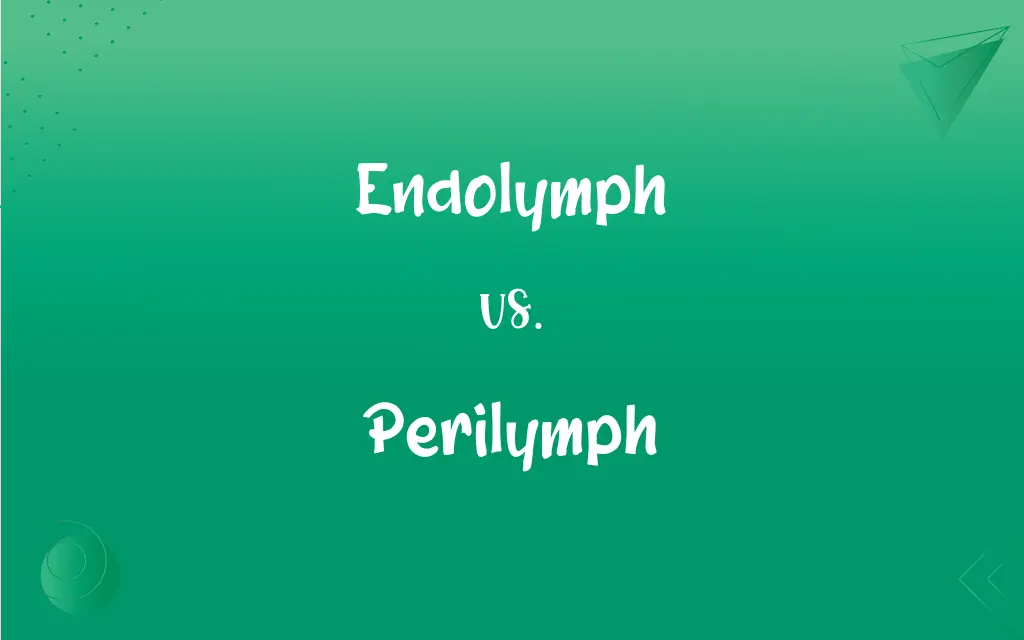Endolymph vs. Perilymph: What's the Difference?
Edited by Aimie Carlson || By Janet White || Published on March 2, 2024
Endolymph is the fluid inside the membranous labyrinth of the ear, crucial for hearing and balance; perilymph surrounds it, providing cushioning and carrying sound vibrations.

Key Differences
Endolymph is a potassium-rich fluid found within the cochlear duct and the vestibular system's membranous labyrinth, playing a crucial role in the process of hearing and maintaining balance. Its unique ionic composition is essential for converting sound vibrations into electrical signals that the brain can interpret. Perilymph, on the other hand, is a sodium-rich fluid that fills the space between the bony labyrinth and the membranous labyrinth of the inner ear. It acts as a protective cushion for the delicate structures within the membranous labyrinth and is involved in transmitting sound vibrations from the outer ear to the cochlear duct.
The primary distinction between endolymph and perilymph lies in their location and chemical composition. Endolymph's high potassium content contrasts sharply with perilymph's high sodium content, reflecting their different roles in auditory and vestibular functions. These fluids work together to ensure the proper functioning of the inner ear.
Endolymph's role extends beyond merely filling the membranous labyrinth; it directly participates in the mechanical-to-electrical transduction process necessary for hearing and balance. Its composition is meticulously maintained by specialized cells, highlighting its importance in inner ear physiology. Perilymph, while not directly involved in the transduction process, facilitates the transmission of sound vibrations and provides a supportive environment for the membranous labyrinth. Its presence is vital for the overall integrity and function of the inner ear, protecting its structures from physical damage and maintaining a stable ionic environment.
Comparison Chart
Location
Inside the membranous labyrinth.
Between the membranous and bony labyrinths.
Ionic Composition
High in potassium.
High in sodium.
ADVERTISEMENT
Function
Involved in converting sound vibrations into electrical signals.
Cushions and transmits sound vibrations to the inner ear.
Role in Balance
Essential for sensing gravity and motion.
Supports the membranous labyrinth, indirectly affecting balance.
Maintenance
Composition maintained by cells in the stria vascularis.
Composition less tightly regulated, similar to cerebrospinal fluid.
Endolymph and Perilymph Definitions
Endolymph
The potassium-rich fluid within the inner ear's cochlear duct and vestibular apparatus.
The endolymph's movement within the cochlea is crucial for hearing.
Perilymph
The sodium-rich fluid surrounding the inner ear's membranous labyrinth.
Perilymph acts as a shock absorber, protecting inner ear structures.
ADVERTISEMENT
Endolymph
Directly participates in the sensory processes of balance and hearing.
Displacement of endolymph causes stimulation of hair cells.
Perilymph
Provides a protective cushioning for the delicate membranous labyrinth.
The perilymph's presence ensures stability in the inner ear's environment.
Endolymph
Maintained by the stria vascularis, reflecting its importance in ear function.
The endolymph's ionic balance is critical for inner ear health.
Perilymph
Its volume and composition are crucial for normal ear function.
Abnormal perilymph pressure can lead to vestibular disorders.
Endolymph
Essential for converting mechanical sound waves into nerve impulses.
Abnormalities in endolymph can lead to hearing loss.
Perilymph
Transmits sound vibrations to the cochlear duct from the middle ear.
Movement of perilymph is vital for the initial stages of hearing.
Endolymph
Its unique composition distinguishes it from other body fluids.
The high potassium level in endolymph supports its function in the transduction process.
Perilymph
Chemically similar to cerebrospinal fluid, reflecting its protective role.
The composition of perilymph facilitates efficient sound transmission.
Endolymph
The fluid in the membranous labyrinth of the inner ear.
Perilymph
The fluid in the space between the membranous and bony labyrinths of the inner ear.
Endolymph
(anatomy) The watery fluid inside the membranous labyrinth of the inner ear.
Perilymph
An extracellular fluid found in the scala tympani and scala vestibuli of the cochlea.
Endolymph
The watery fluid contained in the membranous labyrinth of the internal ear.
Perilymph
The fluid which surrounds the membranous labyrinth of the internal ear, and separates it from the walls of the chambers in which the labyrinth lies.
Endolymph
The bodily fluid that fills the membranous labyrinth of the inner ear
Perilymph
The bodily fluid that fills the space between the bony labyrinth and the membranous labyrinth of the inner ear
FAQs
Can changes in endolymph cause medical conditions?
Yes, abnormalities can lead to conditions like Ménière's disease.
What is endolymph?
A potassium-rich fluid inside the cochlear duct and vestibular system, crucial for hearing and balance.
What is perilymph?
A sodium-rich fluid that surrounds the membranous labyrinth, providing cushioning and sound transmission.
Why are endolymph and perilymph important?
They are vital for the inner ear's function, affecting hearing and balance.
How does perilymph transmit sound vibrations?
It carries vibrations from the middle ear to the cochlear duct.
What happens if perilymph leaks?
A leak can cause hearing loss and balance disorders.
How do endolymph and perilymph differ in composition?
Endolymph is high in potassium, whereas perilymph is high in sodium.
What role does the stria vascularis play regarding endolymph?
It maintains the ionic composition of endolymph.
How does perilymph protect the inner ear?
It cushions the membranous labyrinth and supports its structure.
Is endolymph similar to other body fluids?
No, its high potassium content makes it unique.
What is the significance of potassium in endolymph?
It's essential for the electrochemical processes involved in hearing and balance.
Can disorders of the inner ear affect both fluids?
Yes, diseases can disrupt the balance and function of both fluids.
How are issues with these fluids diagnosed?
Diagnostic methods include hearing tests, balance assessments, and imaging.
What causes fluctuation in endolymph volume?
Conditions like Ménière's disease can lead to increased volume.
Can perilymphatic pressure affect hearing?
Yes, abnormal pressure can impair auditory function.
What research is being done on these fluids?
Studies focus on understanding their roles in hearing and balance disorders.
What treatments exist for disorders involving these fluids?
Treatments range from medication to manage symptoms to surgeries for severe cases.
How does sodium in perilymph facilitate its functions?
Its ionic balance aids in sound transmission and provides neuroprotection.
How are endolymph and perilymph maintained within the ear?
Specialized cells and barriers regulate their composition and volume.
How do endolymph and perilymph interact?
Though physically separate, their functions are interdependent for ear health.
About Author
Written by
Janet WhiteJanet White has been an esteemed writer and blogger for Difference Wiki. Holding a Master's degree in Science and Medical Journalism from the prestigious Boston University, she has consistently demonstrated her expertise and passion for her field. When she's not immersed in her work, Janet relishes her time exercising, delving into a good book, and cherishing moments with friends and family.
Edited by
Aimie CarlsonAimie Carlson, holding a master's degree in English literature, is a fervent English language enthusiast. She lends her writing talents to Difference Wiki, a prominent website that specializes in comparisons, offering readers insightful analyses that both captivate and inform.







































































